Intro – Jake’s Take ❄️
Alright, folks—let’s talk about the great AC freeze-up mystery. Nothing like walking into your house during a heatwave, expecting a cool breeze... and finding your air conditioner’s turned into a dang glacier. I’ve seen it more times than I care to count, and trust me—it’s fixable. You just gotta understand the “why” before you tackle the “how.”
And while you’re at it, don’t forget to check out your coil setup over at The Furnace Outlet—it might just be time for an upgrade. Let’s crack into the frosty truth, shall we?
What's Freezing Up? Understanding the Basics
When we say your “AC is freezing,” we’re really talking about evaporator coils icing over. These coils are the heart of your cooling system—they absorb heat from your home’s air. If they ice up, airflow stops, your system strains, and suddenly you're sweating through July with no relief.
Here’s the thing: those coils shouldn’t freeze. If they do, it’s usually due to one (or more) of these five culprits:
1. Airflow Issues: Dirty Filters and Blocked Vents
Let’s start with the low-hanging fruit: restricted airflow. Your evaporator coils need a steady stream of warm air passing over them to function properly. If air can’t move through, the coil temp drops below freezing, and boom—ice city.
Common airflow blockers include:
-
Clogged air filters
-
Closed or blocked vents
-
Debris in return ducts
Changing your filter regularly is an easy fix. According to Energy Star, you should be replacing filters every 1–3 months depending on usage. Don’t cheap out—a quality filter goes a long way.
2. Low Refrigerant Levels
Here’s where it gets a bit more technical. Low refrigerant leads to a pressure drop in your evaporator coil. That reduced pressure causes temperatures to fall below freezing, and any humidity in the air? Instantly turns to ice.
Most of the time, low refrigerant means you’ve got a leak somewhere. And trust me, finding that leak isn’t always DIY-friendly. It’s usually time to bring in a pro who can do a pressure test, find the leak, and recharge the system with refrigerant—preferably R-32 if you’re thinking ahead.
If you want the deep dive, Trane breaks down signs your system is running low.
3. Thermostat or Control Problems
Thermostat set too low? Or maybe it’s malfunctioning? If your system’s running longer than it should, you could be overcooling the coils. Eventually, that moisture in the air freezes up.
Smart thermostats like the ecobee or Nest are excellent at regulating runtime and spotting issues before they snowball—literally. Check out this thermostat guide by CNET to find one that matches your system and budget.
4. Dirty Evaporator Coils (a classic)
Dirt acts like insulation on your coils. When it builds up, heat transfer drops, refrigerant lingers longer inside the coil, and—you guessed it—freezing starts.
I’ve said it a hundred times: clean your coils. Use a soft brush, mild detergent, or no-rinse foaming cleaner. Just don’t go at it with a pressure washer. And if you want step-by-step tips, this guide from CRC Industries is gold.
5. Faulty Blower Fan or Motor
Your blower is responsible for pushing air over the coils. If it’s slowing down, running intermittently, or has completely failed, your system isn’t getting enough airflow. The result? Frostbite for your evaporator.
You might hear strange noises, experience inconsistent cooling, or see your system short cycling. If so, test the blower and capacitor—or better yet, get a tech in there to verify what’s up.
What You Can Do (Before Calling in the Cavalry)
Here’s Jake’s game plan for handling a frozen coil situation yourself:
✅ Step 1: Turn off your AC completely (not just the thermostat—use the breaker if needed).
✅ Step 2: Switch the fan to “ON” mode to circulate warm air and start thawing.
✅ Step 3: Replace your air filter.
✅ Step 4: Visually inspect vents and coils for dust, dirt, or debris.
✅ Step 5: Wait. Seriously. Give it a few hours before turning things back on.
If things start working again, great. But if your system refreezes? You’ve likely got a refrigerant or electrical problem. Time to call in an HVAC pro.
Need a new coil? Browse evaporator coils here—you might find your fix faster than you think.
Prevent It From Happening Again
Here’s the golden rule: maintenance matters. You can avoid 90% of freeze-up issues by staying on top of:
-
Filter changes 🗓️
-
Annual coil cleaning 🧼
-
Smart thermostat use 🤖
-
Professional tune-ups 🔧
And if your system’s creeping up on the 10- to 15-year mark, it might be time for a refresh. Upgrading to a newer unit with R-32 refrigerant is smarter, greener, and more efficient long term. Learn more from Daikin about the environmental edge R-32 brings to the table.
Jake’s Final Word 🧊
Look—I get it. A frozen AC feels like the end of the world in the middle of July. But it’s just your system’s way of telling you something’s off. Pay attention to the signs, don’t ignore basic upkeep, and when in doubt—swap that coil or get a tech on site.
And remember: If your current coil’s shot or your system’s struggling, head over to The Furnace Outlet’s evaporator coil collection. Trust me, they’ve got options that fit your setup—and your wallet.
Curious about the cost of evaporator coil replacement? Visit my guide: Jake’s Guide to What’s Fair—and What’s a Ripoff.
Until next time, keep it chill (but not too chill). ❄️✌️
– Jake, your comfort loving tech







